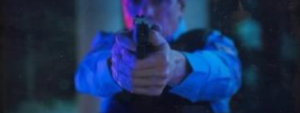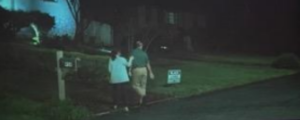107 Emergency (2022)
Analyzing the film: Emergency (2022)
by Russell Hueso
Within the last two decades, streaming has become the newest method for the average person to watch a film at home. This advancement in technology and growth of viewership has led streaming services to create their own films and shows for their own platform. This pushes away from the traditional wait in lines or driving to your local theater for the newest film release. Amazon Prime Video has recently produced another great film this last year known as Emergency. This film is of no extra cost for any person who has an Amazon Prime membership. Emergency depicts many factors of difference, power, and discrimination faced in America today, particularly by black males. In this essay, I analyze scenes in the film to reveal their interpretation.
In order to understand the main idea of the film, a breakdown of the main characters must be introduced. The film’s narrative focuses on the weekend of two young black males who are friends. Though both friends have different social and economic backgrounds, they share commonalities in attending a predominantly white university. Sean is a carefree individual who comes from a difficult life filled with crime and poverty. Kunle comes from a wealthy, college-educated family. The friends’ weekend takes a turn for the worst as the antagonist presents itself in their home as a young white female who is unconscious and not known to either of the characters. Later she reveals her name is Emma. A semi-conscious Emma reveals to the supporting character, Carlos, the roommate of Sean and Kunle, that she is a seventeen-year-old high school student.
The film establishes the difference between white society and the acceptance of black individuals. If we take a close focus on a scene in Emergency, time stamp: 05:59, the film proceeds to a jump cut of the Black Student Union on campus with a voice-over of the characters explaining all the achievements made at the university thus far. The sound used in the background is a trumpet solo with the tempo and rhythm of Blues music, which is a token of their African-American heritage. One of the achievements narrated was of a black student being able to step foot in a Fraternity— a minor achievement, but a breakthrough of change. The film is humorously trying to make the connection between majority white fraternity chapters and that “ most fraternities abolished racial discrimination clauses from their membership criteria in the late 1960s” (Brian, 2018).
Black Student Union; screen snip from Emergency,

The interpretation of power is a fundamental idea that most people associate with government or influence. The film establishes this narrative really well near the end of the film at timestamp 1:17:12, after a long night of trying to get Emma to a hospital and being chased by Emma’s sister. The sister had perceived the whole night as an attempt of strangers’ kidnapping Emma, leading her to call the police for assistance before meeting Sean and Kunle. As the group arrived at the hospital after an intense car chase, numerous police cars surrounded the van. The cinematography transitions from a wide lens of the ambiance, to a close-up shot of the officer’s gun, and then switches to Kunle. To emphasize the harsh reality of the situation, the sounds played in the background are high-pitched ringing merged with eerie music. Kunle is visibly crying and shocked as he is unsure of how to react because of the skewed perception of himself painted as a possible kidnapper by Emma’s sister. Kunle understands the risks of police brutality. Throughout the film, Sean expressed to Kunle that any interaction with the police would lead to them being shot due to their race. As expressed, “a key factor explaining the predominance of African Americans among victims of police brutality is antiblack racism among members of mostly white police departments” (Moore, 2023). The film used this scene as an expression of the social issues in the United States today with police brutality.

The film represented direct discrimination towards Sean and Kunle from minor white characters. It was not necessary to decode this as the minor characters approached Sean and Kunle while parked in a neighborhood, yelling at them to “stop selling drugs” and “we called the cops”. The issue with this is the characters were well dressed in button-up shirts and slacks. They did not appear threatening. It was due to their skin tone that led to outrage from the residents due to prejudice. A main point that can be decoded is the scene as the van leaves, there is a shot of the minor characters walking up their driveway and a sign was posted on their lawn at time stamp 41:48. The sign reads “Black Lives Matter” for individuals “ supporters as a resurgence of American civil rights activism, seeks to end police brutality and to inspire a national debate on institutionalized racism within the US justice system”(Issit, 2022). This leads to the idea the couple advocated for a false ideology and are contributing to the issue at hand, which is discrimination as well as police brutality due to false claims. If the officers had arrived on the scene, they would have perceived Kunle and Sean as drug dealers from the reports made by the couple to dispatch.

Analyzing the purpose behind the film from the director’s view, this is “ a function of how plugged-in Dávila’s screenplay is to the specifics of American college life in the early 21st century” ( Seitz, 2022). It is a depiction of the issues happening at the moment with victims of the “Me Too Movement”, which advocates for victims of sexual assault. People have read or seen headlines of these issues that happen within a college town in the United States. The whole focus of constructing a film that builds as it moves forward is to encode different social issues or ideas along the process with the main characters.
The subtle use of background music that aligns with their culture and cinematography that grabs the whole landscape but narrows down to focus on the characters as information is revealed. The editing throughout the film jump-cut without further information as the viewer follows the characters along their journey and internal issues they are facing individually. Sean is hoping to save the night and accomplish the “legendary tour” as a way to say farewell to his university friend Kunle. While Kunle is trying to save his laboratory experiment as he is an accomplished student trying to excel in academia in the last few months of his undergraduate degree. These are concerns that a typical student can face on a day-to-day basis that the director implements perfectly.
The appeal this movie brought to me is the likelihood of this situation happening. As a college student who enjoys celebrating with friends, people consume alcohol at these events. I have witnessed individuals overly intoxicated where they no longer have proper motor functions. Knowing people in my town as well that don’t lock their doors in order to make accessing their house for visitors easier for events. Stumbling into a stranger’s home while intoxicated can happen if you are alone, as Emma did in this film.
Wrapping it all up, Emergency encodes numerous social issues within the film. Through the lens of two black male lead actors and factors of difference, power, and discrimination faced in America today. Covering issues from police brutality, Black Lives Matter, and the Me Too Movement all in the life of a college student. This film successfully builds on these issues while still being a light-hearted comedy and drama that will hold the audience in suspense at times.
References
Issitt, Micah. “Black Lives Matter Movement: Overview.” Points of View: Black Lives Matter Movement, Sept. 2022, pp. 1–4. EBSCOhost, search.ebscohost.com /login.aspx?direct=true&db=pwh&AN=120615801&site=eds-live&scope =site.
Joyce, Brian. “Perceptions of Race and Fit in the Recruitment Process of Traditionally, Predominantly White Fraternities.” Oracle: The Research Journal of the Association of Fraternity/ Sorority Advisors. William & Mary, https://scholarworks.wm.edu/cgi/viewcontent.cgi?article=115 3&context=oracle.
Moore, Leonard. “Police Brutality in the United States.” Encyclopædia Britannica, Encyclopædia Britannica, Inc., 16 Mar. 2023,https://www.britannica.com /topic/police-brutality-in-the-United-States-2064580.
Seitz, Matt Zoller. “Emergency Movie Review & Film Summary (2022): Roger Ebert.” Movie Review & Film Summary (2022) | Roger Ebert, Roger Ebert , https://www.rogerebert.com/reviews/emergency-movie-review-2022.

